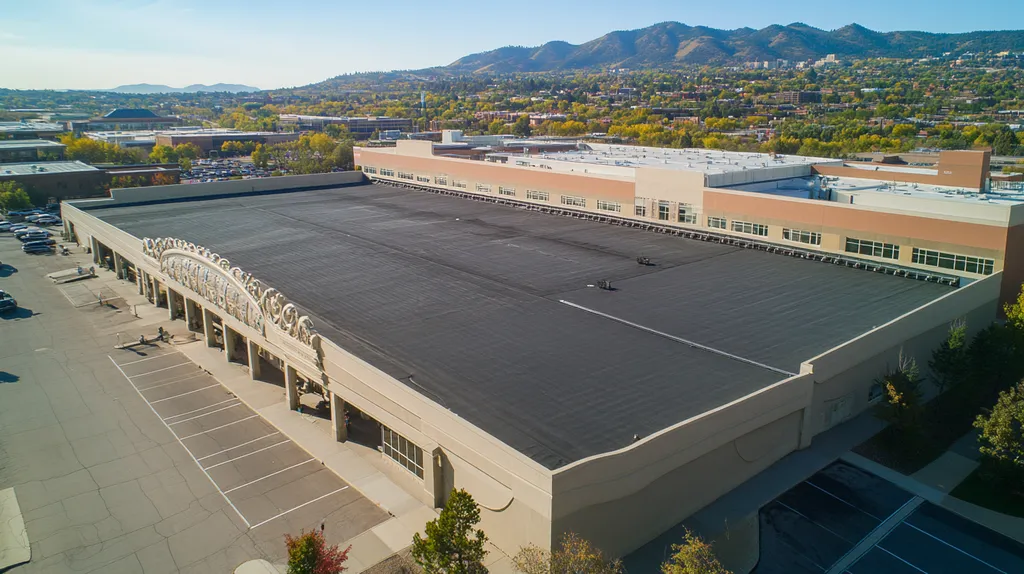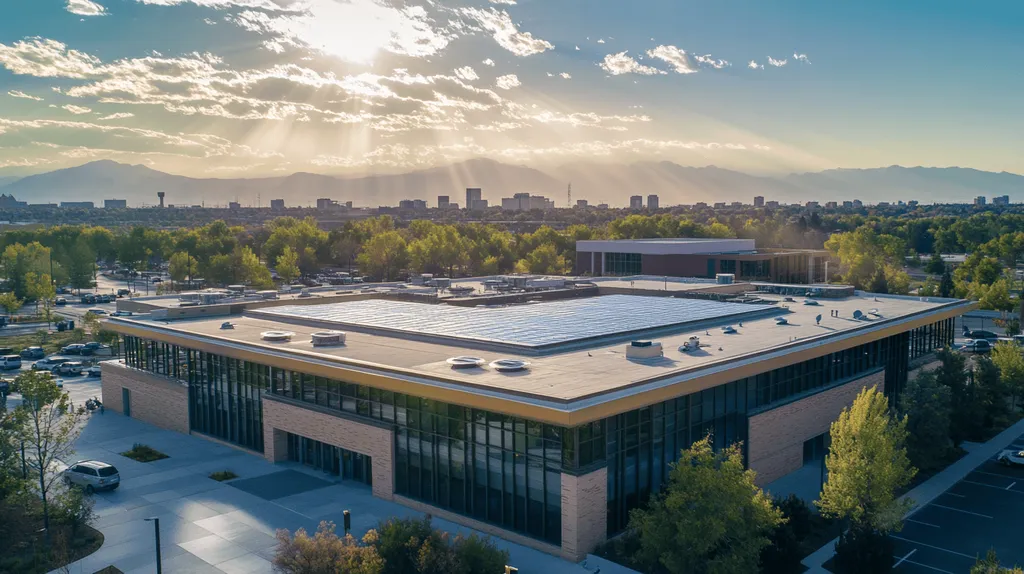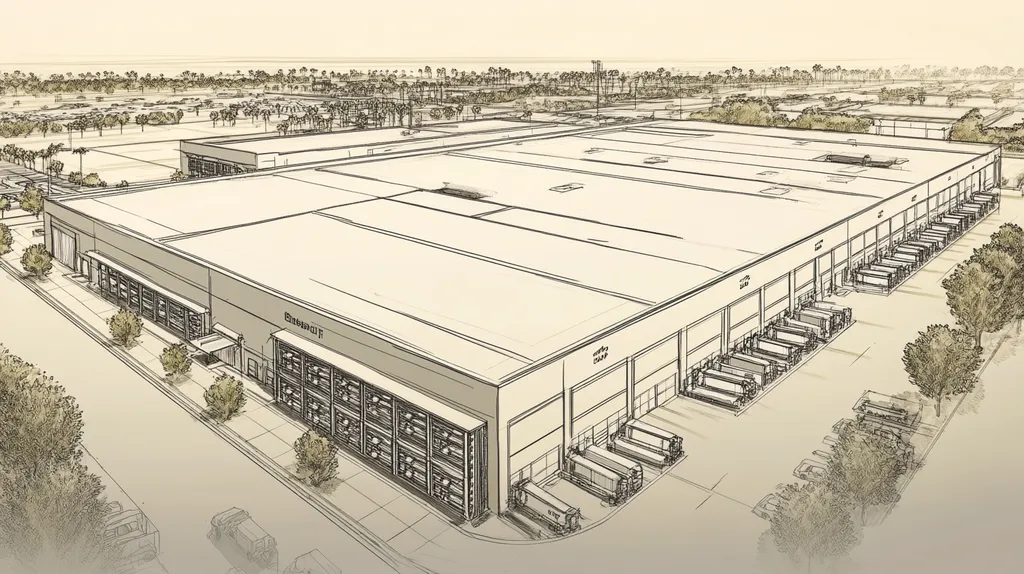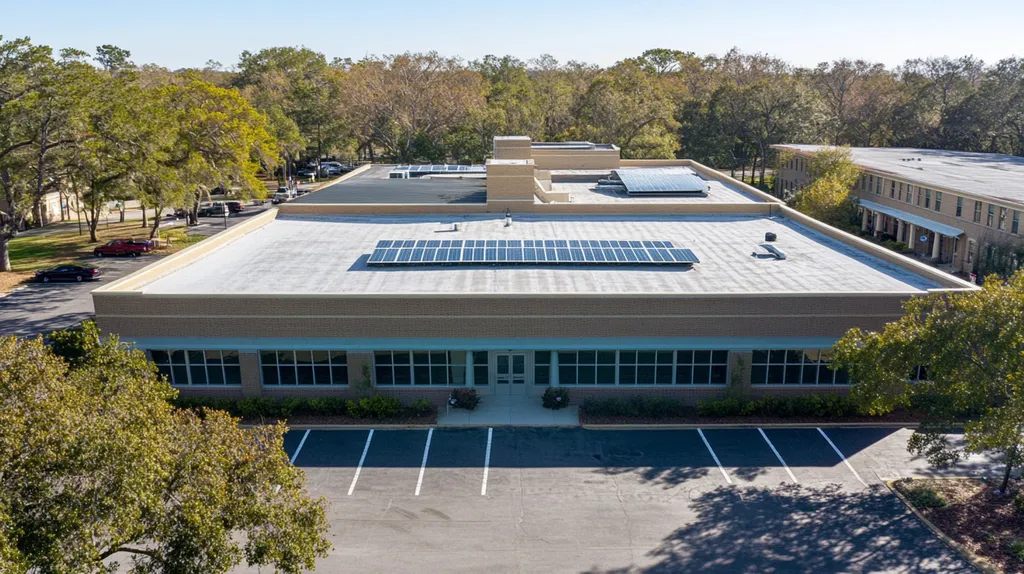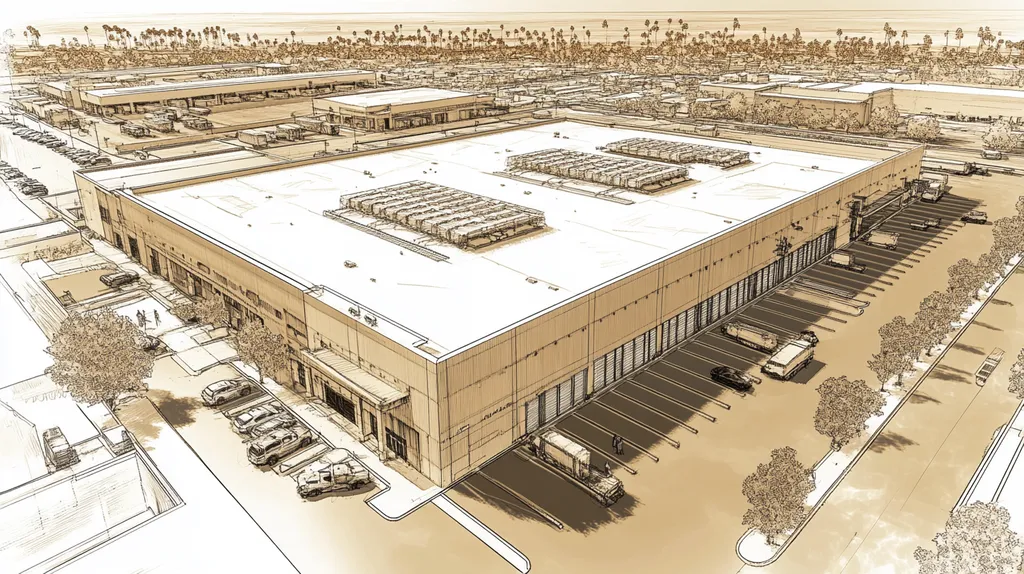In today’s industrial facilities, roofing decisions can make the difference between profit and loss. Studies show that poor roof reflectivity management costs U.S. businesses over $3 billion annually in preventable cooling expenses.
Rising energy costs and stricter environmental regulations have pushed reflective roofing systems to the forefront of facility management priorities. Modern reflective materials can reduce peak cooling loads by up to 40% while extending HVAC system lifespans.
This comprehensive guide examines the critical aspects of industrial roof reflectivity, from fundamental concepts through optimization strategies, providing facility managers with actionable insights for improving energy efficiency.
SECTION 1: FUNDAMENTAL CONCEPTS
Roofing decisions have profound implications for industrial facility operating costs and environmental impact. Studies indicate that effective roof reflectivity management can reduce cooling costs by up to 40% in warm climates. With energy prices continuing to rise, understanding how roofing choices affect building temperature control has become a critical factor in facility management.
Understanding Reflectivity Basics
A conventional dark roof can reach temperatures exceeding 150°F on summer afternoons, while reflective roofing surfaces often remain 50°F cooler under identical conditions. This dramatic temperature difference directly impacts building cooling requirements and energy consumption. (source: U.S. Department of Energy)
Roof reflectivity is measured on a scale from 0 to 1, with higher numbers indicating greater reflective capacity. Most traditional dark roofs score below 0.2, reflecting less than 20% of solar radiation.
Modern reflective roofing materials can achieve ratings above 0.7, meaning they reflect more than 70% of incoming solar energy. This significantly reduces heat transfer into the building structure.
The effectiveness of reflective roofing depends on surface maintenance and environmental conditions. Regular cleaning and inspection help maintain optimal performance levels over time.
Solar Energy and Heat Transfer
Solar radiation affects buildings through three primary mechanisms: reflection, absorption, and transmission. Understanding these processes is crucial for managing facility cooling loads.
When sunlight strikes a roof surface, the absorbed portion converts to heat energy. This thermal energy transfers through the roofing system into the building interior.
The rate of heat transfer depends on both material properties and temperature differences. Greater temperature disparities between roof surface and interior space result in faster heat movement.
Proper insulation works in conjunction with surface reflectivity to control heat flow. Together, these elements form a comprehensive thermal management strategy.
Urban Heat Island Effects
Dense urban environments typically experience temperatures 5-10°F higher than surrounding rural areas. This temperature differential stems largely from heat-absorbing building materials and reduced natural cooling surfaces.
Large industrial facilities with traditional dark roofs contribute significantly to local heat island effects. These thermal impacts extend beyond individual buildings to affect entire neighborhoods.
Reflective roofing systems help mitigate urban heat island intensity by reducing the amount of absorbed solar energy. This benefit becomes particularly important in industrial parks and manufacturing districts.
The cumulative effect of multiple reflective roofs can measurably reduce ambient temperatures across urban areas. This cooperative impact makes reflective roofing an important tool for community-wide climate management.
SECTION 2: SYSTEM COMPONENTS
Modern industrial roofing systems require careful integration of multiple components to achieve optimal energy efficiency. Current market data shows facilities can reduce cooling costs by 25-40% through strategic component selection. Understanding these critical elements helps facility managers make informed decisions that impact both operational costs and environmental footprint.
Reflective Roof Coatings and Membranes
A cool roof is designed to reflect more sunlight than a conventional roof, absorbing less solar energy. This lowers the temperature of the building, reducing strain on cooling systems and extending HVAC equipment life. (source: U.S. Department of Energy)
Modern reflective coatings offer durability ratings exceeding 15 years when properly maintained. These materials maintain their reflective properties through harsh weather conditions and temperature fluctuations.
Single-ply membranes with reflective properties have become increasingly popular due to their combination of durability and energy performance. These materials offer excellent resistance to UV radiation while maintaining high reflectivity values.
Installation methods for reflective systems have evolved to ensure maximum coverage and effectiveness. Proper application techniques are crucial for achieving optimal performance and longevity.
Insulation Materials and Thermal Barriers
Thermal barriers serve as the primary defense against heat transfer through the roof assembly. Modern insulation materials can achieve R-values above 6.0 per inch, dramatically reducing thermal conductivity.
Polyisocyanurate remains the most widely used industrial roof insulation, offering superior thermal resistance and moisture protection. Its closed-cell structure provides excellent dimensional stability and compression strength.
Multi-layer insulation systems allow for thermal breaks and enhanced performance. Staggered joints between layers minimize thermal bridging and improve overall system efficiency.
Vapor barriers integrated with insulation systems prevent moisture accumulation that could degrade thermal performance. This protection maintains insulation effectiveness throughout the system’s lifespan.
Energy-Efficient Roofing Materials
Advanced roofing materials now incorporate multiple energy-saving features into single products. These integrated solutions simplify installation while maximizing performance benefits.
Thermoplastic membranes offer excellent durability and energy efficiency through their inherent reflective properties. Their heat-welded seams create a monolithic surface that maintains consistent performance.
Metal roofing systems with specialized coatings provide both durability and energy savings. These materials offer service lives exceeding 40 years while maintaining their energy-efficient properties.
Composite systems combining multiple materials can achieve optimal performance for specific climate conditions. These engineered solutions target regional challenges while maintaining energy efficiency.
SECTION 3: IMPLEMENTATION METHODS
Implementation methods for reflective roofing systems demand precise attention to detail and systematic coordination across multiple building systems. Research shows that properly implemented reflective roofing can reduce peak cooling demand by 10-15% in commercial buildings. However, achieving these benefits requires careful attention to installation quality, HVAC integration, and fundamental design elements.
Proper Installation Techniques
Successful reflective roof installation begins with comprehensive surface preparation and precise material handling. Even minor installation errors can significantly reduce system performance and longevity.
ENERGY STAR qualified roof products must meet strict initial solar reflectance requirements of ≥0.65 for low-slope applications, with specific maintenance criteria for sustained performance. These products also require warranties matching standard industry coverage terms. (source: ENERGY STAR Program Requirements for Roof Products)
Proper seam sealing and flashing installation prevent moisture infiltration that could compromise reflective performance. Quality control measures during installation should include regular inspections of material overlap, adhesion testing, and verification of proper drainage patterns.
Installation timing must account for weather conditions and material temperature requirements. Most reflective coating applications require specific temperature and humidity ranges for optimal curing and performance.
Integration with HVAC Systems
Reflective roofing systems must work in concert with HVAC equipment to maximize energy efficiency benefits. Proper integration starts with strategic placement of rooftop units to prevent interference with reflective surfaces.
Careful attention to equipment clearances and maintenance access ensures that service activities won’t damage reflective coatings. Regular cleaning schedules for both HVAC components and roof surfaces maintain optimal system performance.
Coordination between roofing and mechanical contractors during installation prevents potential conflicts. This includes proper flashing of mechanical penetrations and appropriate protection of reflective surfaces during HVAC maintenance.
Energy monitoring systems should track both roof surface temperatures and HVAC performance metrics. This data helps facility managers optimize system settings and verify energy savings.
Design Considerations for Slope
Roof slope directly impacts both drainage efficiency and reflective coating performance. Minimum slope requirements ensure proper water management while maintaining reflective material integrity.
Different reflective materials perform optimally at specific slope ranges. Material selection must account for both initial installation angles and potential settling or deflection over time.
Tapered insulation systems can create positive drainage while maintaining energy efficiency. These systems require careful design to prevent ponding water without creating excessive slopes that could affect coating application.
Strategic placement of drainage components prevents water accumulation that could degrade reflective surfaces. Proper slope design also facilitates easier maintenance and cleaning of reflective coatings.
SECTION 4: MAINTENANCE REQUIREMENTS
Maintaining industrial roof reflectivity directly impacts both energy costs and system longevity. Studies show that poorly maintained reflective roofs can lose up to 35% of their energy-saving potential within the first year alone. Understanding and implementing proper maintenance protocols has become essential as more facilities adopt reflective roofing to combat rising energy costs and meet sustainability goals.
Regular Inspection Protocols
Professional roof inspections should occur at minimum twice annually, with additional checks following severe weather events. These inspections must assess surface reflectivity, membrane integrity, and drainage system functionality.
Key inspection points include seam integrity, flashing conditions, and signs of ponding water. Even minor surface damage can compromise reflective properties and accelerate deterioration.
Modern inspection techniques utilize infrared scanning and reflectivity meters to identify problem areas. These tools help quantify performance losses and prioritize maintenance needs.
Documentation of each inspection creates a performance history that helps predict maintenance needs and validate energy savings. This data drives informed decisions about repairs and replacements.
Cleaning and Repair Strategies
Surface cleanliness directly affects reflective performance and energy efficiency. Reflective roofing provides measurable energy efficiency improvements in most U.S. cities, particularly when demand charges exceed $6.25. (source: MDPI – Buildings Journal)
Pressure washing systems must operate at appropriate pressures to prevent surface damage. Specialized cleaning solutions can remove stubborn stains while preserving reflective coatings.
Repairs require materials specifically designed for reflective roofing systems. Using standard repair products can create dark patches that reduce overall system efficiency.
Immediate attention to damage prevents degradation of surrounding areas. Small repairs addressed promptly often prevent more extensive and costly fixes later.
Preventative Maintenance Scheduling
Effective maintenance programs follow detailed schedules based on manufacturer recommendations and local conditions. These schedules must account for seasonal changes and facility-specific factors.
Monthly visual inspections by facility staff can identify developing issues before they become critical. This approach reduces emergency repair needs and extends system lifespan.
Scheduling cleaning operations during moderate weather conditions ensures optimal results. Extreme temperatures can affect cleaning solution effectiveness and drying times.
Annual review and adjustment of maintenance schedules keeps programs aligned with changing facility needs. This flexibility allows for optimization based on observed performance patterns.
SECTION 5: PERFORMANCE METRICS
Performance metrics provide essential benchmarks for evaluating roofing system effectiveness and energy efficiency. Without proper measurement and monitoring, facilities can waste up to 40% of their cooling costs through inefficient roofing choices. Understanding and tracking key metrics like Solar Reflectance Index (SRI), thermal emittance, and compliance standards enables facility managers to make data-driven decisions that significantly impact both operational costs and environmental footprint.
Solar Reflectance Index (SRI)
The Solar Reflectance Index provides a standardized way to measure a roof’s ability to reject solar heat. This single value combines both reflectance and emittance measurements into an easily comparable metric.
Modern reflective roofing materials can achieve SRI values above 100, while traditional dark surfaces often score below 20. This dramatic difference directly impacts cooling loads and energy consumption.
Regular SRI testing helps track performance degradation over time. Even small decreases in reflectivity can significantly impact energy efficiency and should trigger maintenance interventions.
Building codes increasingly specify minimum SRI values for commercial roofing. Understanding these requirements helps facility managers plan upgrades and replacements effectively.
Thermal Emittance and Heat Transfer
Reflective roof membranes significantly lower air conditioning costs by reducing thermal energy transfer through the roof assembly. Studies confirm net annual energy savings across most U.S. cities, even in regions with substantial heating requirements. (source: MDPI – Buildings Journal)
Thermal emittance values range from 0 to 1, with higher numbers indicating better heat rejection. Most high-performance roofing materials achieve emittance ratings above 0.85.
Heat transfer through roofing assemblies occurs through conduction, convection, and radiation. Understanding these mechanisms helps optimize system design for maximum efficiency.
Temperature monitoring systems can track actual heat transfer rates. This data helps validate performance and identify areas needing improvement.
Energy Efficiency Standards Compliance
Current building energy codes establish minimum requirements for roof system performance. These standards typically address both initial and aged reflectivity values.
Compliance documentation must include test results from approved laboratories. These certifications protect building owners and ensure marketed performance claims are legitimate.
Regular compliance audits help maintain certification status. These reviews should examine both physical conditions and performance metrics.
Many jurisdictions offer incentives for exceeding minimum standards. Understanding these programs can help offset the costs of high-performance roofing systems.
SECTION 6: OPTIMIZATION STRATEGIES
Optimizing industrial roof reflectivity represents a critical opportunity for facility managers seeking to control escalating energy costs. Modern reflective roofing systems can reduce cooling energy consumption by up to 25% during peak summer months, but achieving these savings requires systematic optimization. According to Capital Roof Care, a reflective roof can maintain temperatures 50°F cooler than traditional roofing surfaces, dramatically impacting facility cooling loads and operating costs. (source: Capital Roof Care)
Enhancing Reflectivity Over Time
Surface degradation represents the primary threat to long-term reflective performance. Regular cleaning protocols must remove accumulated dirt, debris, and biological growth that can diminish reflective properties.
Periodic recoating with high-performance reflective materials helps restore original performance levels. Modern coating systems can extend reflective properties for 5-7 years when properly maintained.
Environmental monitoring helps identify factors affecting reflectivity performance. Changes in surrounding structures, vegetation, or air quality can impact system effectiveness.
Documentation of reflectivity measurements creates performance trending data. This information drives maintenance scheduling and validates energy savings claims.
Combining with Green Building Technologies
Integration of reflective roofing with other sustainable building systems multiplies energy savings potential. Vegetative roof sections can complement reflective surfaces while providing additional insulation value.
Solar panel installations benefit from reflective surrounding surfaces. Increased ambient light reflection can boost photovoltaic efficiency by 5-15%.
Advanced insulation systems work synergistically with reflective surfaces. This combination optimizes both summer cooling and winter heat retention.
Rainwater collection systems can incorporate roof cleaning functions. This dual-purpose approach maintains reflectivity while supporting water conservation goals.
Energy Monitoring and Control Systems
Real-time monitoring of roof surface temperatures provides immediate performance feedback. This data enables rapid response to reflectivity degradation or system failures.
Integration with building automation systems optimizes HVAC operation. Reduced heat loads from reflective roofing allow for dynamic adjustment of cooling systems.
Thermal imaging surveys identify areas of compromised performance. Regular scanning helps target maintenance efforts and verify system integrity.
Performance data tracking validates energy savings and ROI calculations. This documentation supports budget planning and future improvement initiatives.
The Bottom Line
With energy costs continuing to rise by 5-7% annually, industrial facilities cannot afford to ignore roof reflectivity optimization. Studies show that properly maintained reflective roofing systems can reduce cooling costs by up to 40% while extending HVAC system lifespans by 3-5 years.
The integration of advanced materials, precise installation methods, and systematic maintenance protocols has made reflective roofing a cornerstone of modern facility management. Regular monitoring and optimization of these systems delivers measurable returns through reduced energy consumption and extended service life.
As environmental regulations tighten and energy prices climb, facilities that fail to implement comprehensive reflective roofing strategies risk falling behind competitors while bearing unnecessary operational costs. The time for action is now.
FREQUENTLY ASKED QUESTIONS
Q. How does a commercial roof’s reflectivity impact energy costs?
A. A commercial roof’s reflectivity significantly affects energy costs by influencing cooling requirements. Efficient roofs can help reduce these costs by maintaining lower interior temperatures, thus decreasing the strain on HVAC systems. Understanding this relationship is crucial for optimizing energy efficiency and managing operational expenses.
Q. What are the best materials for an industrial roof system?
A. The best materials for an industrial roof system include reflective coatings, single-ply membranes, and metal roofs. Reflective options can enhance energy efficiency, while durable materials ensure longevity. Selecting the right components depends on specific environmental conditions and facility requirements.
Q. How can I ensure proper installation of reflective roofing systems?
A. Ensuring proper installation of reflective roofing requires meticulous surface preparation, quality materials, and adherence to specifications. It’s essential to follow manufacturer guidelines and conduct regular inspections throughout the process. These steps help fulfill energy-saving potential and extend system lifespan.
Q. What maintenance is needed for reflective roofs?
A. Reflective roofs require regular inspections to assess damage, clean surfaces, and repair any wear. Addressing issues promptly can prevent significant performance loss and degradation. Following a structured maintenance schedule helps maintain efficiency and prolongs the lifespan of the roofing system.
Q. What performance metrics should I track for my commercial roof?
A. Important performance metrics include Solar Reflectance Index (SRI), thermal emittance, and compliance standards. Tracking these figures ensures effective energy management and optimal system performance. Regular evaluations can help identify issues that may affect energy efficiency and operational costs.
Q. How can I optimize energy efficiency in industrial roofing?
A. Optimizing energy efficiency involves enhancing roof reflectivity, integrating effective insulation, and monitoring energy consumption. Regular maintenance and strategic upgrades can significantly lower cooling costs while improving overall system performance. Employing energy monitoring systems can help track efficiency and validate savings.
Q. Are there any environmental benefits to reflective roofing?
A. Yes, reflective roofing helps reduce urban heat island effects and lower energy consumption. By reflecting sunlight, these roofs decrease surrounding temperatures and enhance indoor comfort levels. This contributes to sustainability goals and reduces carbon footprints associated with traditional roofing materials.

